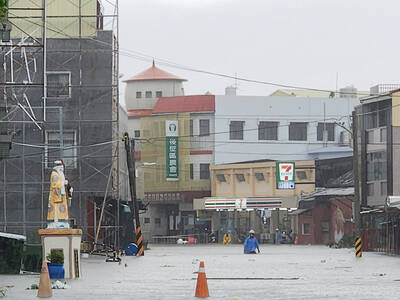Wall Street suffered the slings and arrows of one of the most tumultuous years in stock market history last year, but managed a stunning recovery that eclipsed a weak finish.
Wall Street stocks stumbled on Thursday amid thin volumes as many traders were away from their desks ahead of the New Year holiday yesterday.
The Dow Jones Industrial Average slid 1.19 percent to 10,428.05.

PHOTO: BLOOMBERG
The technology-rich NASDAQ composite shed 0.97 percent at 2,269.15 and the broad-market Standard & Poor’s 500 index lost 1 percent at 1,115.10.
However, compared with 12 months ago, the blue-chip Dow was up 18.82 percent, its steepest annual gain since 2003.
The NASDAQ gained a whopping 43.89 percent over the year and the S&P 500 index was up 23.45 percent.
Still, the blue-chip Dow remains down 26 percent from its 2007 highs and is still struggling around the 10,000 level first reached in 1999.
The story is similar for the S&P 500 index, up 23.45 percent for last year, but still hovering near 1999 levels and 29 percent below record highs in October 2007.
The NASDAQ has failed to even come close to the boom days that pushed the index above 5,000 in March 2000, but closed last year with a blistering rise of 43.89 percent.
Though the market ended the year with solid gains, that hardly tells the story of a dramatic near-meltdown for the main indexes followed by a rebound that capped the final year of a “lost decade” for stocks.
The market opened last year sinking fast as the financial crisis deepened with the September 2008 collapse of Lehman Brothers. In 2008, the Dow lost 33.84 percent, the steepest drop since 1931, while the S&P slid 38.49 percent. The NASDAQ tumbled 40.54 percent in 2008, the biggest loss year since its creation in 1971.
It was a Depression-like scenario, with the broad market plunging more than 60 percent from October 2007 to March last year — farther and faster than in 1929.
However, by the spring, some began to sense a recovery in the economy, and Wall Street regained confidence, setting up one of the biggest market rallies in history over the ensuing months.
Ed Yardeni, at Yardeni Research, said the market appeared to turn when the S&P index slid to the ominous number of 666.
“When the S&P 500 bounced off 666 on March 6, I felt like Professor Robert Langdon in The Da Vinci Code,” he said.
The question for many investors now is whether this snapback was a “bear market rally” or the beginning of a new bull run that carries the market to new highs.
“Investors are nervous but optimistic heading into the new year,” said Michael Hartnett, chief global equity strategist at Bank of America Merrill Lynch Global Research.
Milton Ezrati, economist and market strategist at investment firm Lord Abbett, said the stock market is still licking its wounds as optimism rebounds.
“It has been a humbling and sobering experience, to say the least,” he said. “But for all the caution taught by the events of 2008-2009, signs of recovery have become unmistakable, and, as expected, the market has moved up in anticipation of the economic improvement likely in 2010.”
Other world markets also recorded a spectacular rebound last year even though the economy was in crisis, but confidence had not been completely restored and there were fears for this year.
In Frankfurt, the market ended the year 23 percent higher, Paris closed 22.32 percent up and London registered a 22.07 percent gain for the year.
In Asia, the rebound was even more spectacular. Shanghai gained 80 percent over the year and Hong Kong 52 percent. In Tokyo, the leading Nikkei index grew by 19.04 percent over the year.
In Europe, the Lisbon stock exchange rose 34 percent over the year, in Brussels it was up 31 percent. Madrid gained 30 percent, Amsterdam 36.34 percent, Milan 19.47 percent and the Swiss market more than 18 percent.
It was a similar situation in the Gulf where all the markets registered gains over the year. In South America, the Sao Paulo stockmarket grew 82 percent for the year.
However, despite improvements in the stock markets, most of the world’s economies remained limp: Growth was generally negative, except in emerging countries such as India, Brazil and China.
Unemployment had exploded, reaching a historic high of 10 percent in the US and 18 percent in Spain.
This year will be a “test year” for the markets, analysts said.
“Investors want to see if the financial system can again function on its own without help,” said Gregori Volokhine, an analyst from the Meeschaert investment group in New York.
Larry Hatheway and Kenny Liew from Swiss Bank UBS predicted the markets would next year see less significant gains than last year.
The analysts said the cautious outlook hinged on economic uncertainties: the dollar-euro relationship, possible price hikes for raw materials, questions over interest rates and the explosion of US and European deficits.

Rainfall is expected to become more widespread and persistent across central and southern Taiwan over the next few days, with the effects of the weather patterns becoming most prominent between last night and tomorrow, the Central Weather Administration (CWA) said yesterday. Independent meteorologist Daniel Wu (吳德榮) said that based on the latest forecast models of the combination of a low-pressure system and southwesterly winds, rainfall and flooding are expected to continue in central and southern Taiwan from today to Sunday. The CWA also warned of flash floods, thunder and lightning, and strong gusts in these areas, as well as landslides and fallen

WAITING GAME: The US has so far only offered a ‘best rate tariff,’ which officials assume is about 15 percent, the same as Japan, a person familiar with the matter said Taiwan and the US have completed “technical consultations” regarding tariffs and a finalized rate is expected to be released soon, Executive Yuan spokeswoman Michelle Lee (李慧芝) told a news conference yesterday, as a 90-day pause on US President Donald Trump’s “reciprocal” tariffs is set to expire today. The two countries have reached a “certain degree of consensus” on issues such as tariffs, nontariff trade barriers, trade facilitation, supply chain resilience and economic security, Lee said. They also discussed opportunities for cooperation, investment and procurement, she said. A joint statement is still being negotiated and would be released once the US government has made

SOUTH CHINA SEA? The Philippine president spoke of adding more classrooms and power plants, while skipping tensions with China over disputed areas Philippine President Ferdinand Marcos Jr yesterday blasted “useless and crumbling” flood control projects in a state of the nation address that focused on domestic issues after a months-long feud with his vice president. Addressing a joint session of congress after days of rain that left at least 31 dead, Marcos repeated his recent warning that the nation faced a climate change-driven “new normal,” while pledging to investigate publicly funded projects that had failed. “Let’s not pretend, the people know that these projects can breed corruption. Kickbacks ... for the boys,” he said, citing houses that were “swept away” by the floods. “Someone has

‘CRUDE’: The potential countermeasure is in response to South Africa renaming Taiwan’s representative offices and the insistence that it move out of Pretoria Taiwan is considering banning exports of semiconductors to South Africa after the latter unilaterally downgraded and changed the names of Taiwan’s two representative offices, the Ministry of Foreign Affairs (MOFA) said yesterday. On Monday last week, the South African Department of International Relations and Cooperation unilaterally released a statement saying that, as of April 1, the Taipei Liaison Offices in Pretoria and Cape Town had been renamed the “Taipei Commercial Office in Johannesburg” and the “Taipei Commercial Office in Cape Town.” Citing UN General Assembly Resolution 2758, it said that South Africa “recognizes the People’s Republic of China (PRC) as the sole